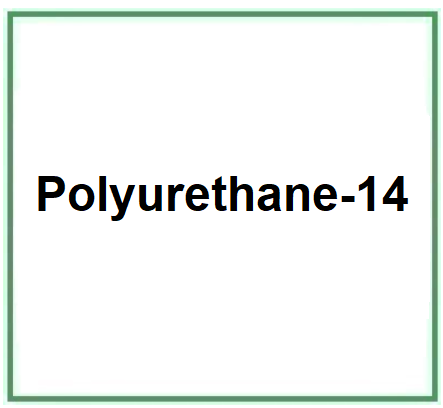Polyurethane-14 is an inorganic chemical compound, a segmented block copolymer derived from Urethane and synthesised from isocyanates.
The name describes the structure of the molecule:
- "Polyurethane" is a term that describes a class of polymers widely used in various applications due to their versatility and desirable properties such as durability, flexibility and abrasion resistance and temperature variations.
- "14" is a reference to the specific type or grade of polyurethane, which can be characterized by such factors as the types of isocyanates and polyols used, their relative amounts, and the presence of any additives. . This is a designation used to differentiate different molecular structures or variants of the polymer. In cosmetic chemistry, these numbers can help formulators identify specific characteristics or behaviors of a given ingredient, particularly when a chemical family has multiple derivatives or forms.
Description of raw materials used in production and their functions.
- Isophorone Diisocyanate. Provides isocyanate groups that react with alcohols and acids to form polyurethane.
- Dimethylol Propionic Acid (DMPA). An alcohol containing both alcohol and carboxylic acid groups, used to introduce hydrophilic end groups in the polymer.
- 4,4'-Isopropylidenediphenol. A bisphenol used as a building block for polymers.
- Propylene Oxide. Reacts with alcohols and acids to form esters and ethers, contributing to the formation of polyurethane.
- Ethylene Oxide. An alkylating agent that can be used to modify polymer properties.
- PEG/PPG-17/3. A mixture of polyethylene glycol and polypropylene glycol, used as a plasticizer and to enhance the water solubility properties of the polyurethane.
Step-by-step summary of industrial chemical synthesis process.
- Dimethylol propionic acid and 4,4'-isopropylidenediphenol are reacted with propylene oxide and ethylene oxide to form a prepolymer.
- This prepolymer is further extended by reacting with PEG/PPG-17/3.
- The extended prepolymer is reacted with isophorone diisocyanate to form Polyurethane-14.
- Significant substances used in production:
- Isophorone diisocyanate, dimethylol propionic acid, and 4,4'-isopropylidenediphenol reacted with propylene oxide, ethylene oxide and PEG/PPG-17/3 copolymer
It appears as a white powder or colorless liquid.

What it is used for and where
Cosmetics
Film-forming agent. It produces a continuous ultra-thin film with an optimal balance of cohesion, adhesion and stickiness on the skin or hair to counteract or limit damage from external phenomena such as chemicals, UV rays and pollution.
Hair conditioning agent. A large number of ingredients with specific purposes can co-exist in a hair shampoo: cleansers, conditioners, thickeners, mattifying agents, sequestering agents, fragrances, preservatives, special additives. However, the indispensable ingredients are the cleansers and conditioners as they are necessary and sufficient for hair cleansing and manageability. The others act as commercial and non-essential auxiliaries such as: appearance, fragrance, colouring, etc. Hair conditioning agents have the task of increasing shine, manageability and volume, and reducing static electricity, especially after treatments such as colouring, ironing, waving, drying and brushing. They are, in practice, dispersing agents that may contain cationic surfactants, thickeners, emollients, polymers. The typology of hair conditioners includes: intensive conditioners, instant conditioners, thickening conditioners, drying conditioners.
Applications
- Hair Care Products - Often used in hair sprays, mousses, and other styling products due to its ability to form a durable, flexible film on the hair.
- Skin Care Products - Can be utilized in lotions, creams, and cosmetics because of its emollient properties and ability to form a protective barrier on the skin.
- Nail Polishes - Due to its durability and flexibility, it might be found in certain nail polishes to enhance the product's longevity and finish.
Safety
Polyurethanes are rather complex, inert and biostable materials that are also used in biomedical applications. They are typically synthesised by the reaction of a glycol or polyol with polyisocyanate or diisocyanate. It is known that exposure to isocyanates can cause asthma, contact allergies, conjunctival and skin irritation. However, a study by the Cosmetic Ingredient Review Expert Panel in 2017 found that the rates of harmful residues are not significant for human health.
Urethane (also called ethyl carbamate) is a by-product of fermentation and is considered a genotoxic agent.
![]() Polyurethane-14
Polyurethane-14 


